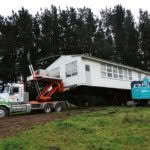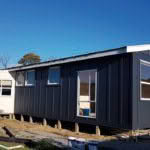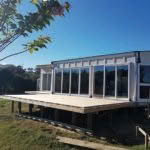An artist finds a unique way to rebuild her home after an earthquake
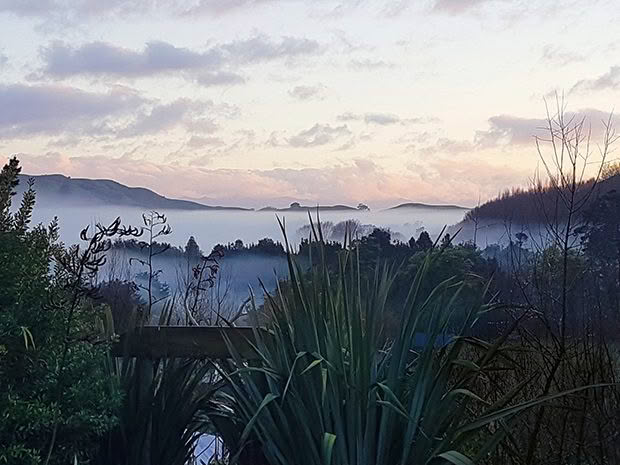
Belinda Paton’s view out to the Ruahine Ranges.
How an artistic spark and a commitment to recycling helped Belinda Paton turn the ruins of her home into a creative sanctuary.
Words and photos: Sheryn Dean
Who: Belinda Paton
Where: Pahiatua, Wairarapa
What: Two hectares (five acres) looking across to the Ruahine Ranges
Social Media: Belinda Paton Creations / Misty Mountain Retreat
At 3.52pm on January 20 2014, Belinda Paton stood outside her home in the Wairarapa and watched her dream turn to dust. The magnitude 6.2 Eketahuna earthquake was rocking her straw bale house two metres from side to side, crumbling the plaster walls before her eyes. “I just stood there watching, saying over and over again: ‘oh my god, oh my god, oh my god’,” Belinda says. “It was crashing back and forth and the earth render was falling off. One minute I was vacuum cleaning, the next minute I was homeless.”
An award-winning potter, painter, mixed media artist, jewellery designer and teacher, Belinda had bought the property just over a year before to establish her art studio
and creative sanctuary. “What better house for a potter to have than a mud house? It was an exciting new beginning for me.”
Art is in Belinda’s blood. Her mother was a potter and art teacher and her father sold art books. She’s been potting since before she could walk and sold her first creations to an art gallery on Auckland’s Queen Street when she was 12 years old. She has been creating, teaching and inspiring others in studios and art schools in New Zealand and Australia ever since. But she always envisaged a school of her own: a tranquil, light-filled space set amongst the mountains where she could create, and others could come to explore, play and bring their artistic flames to life.
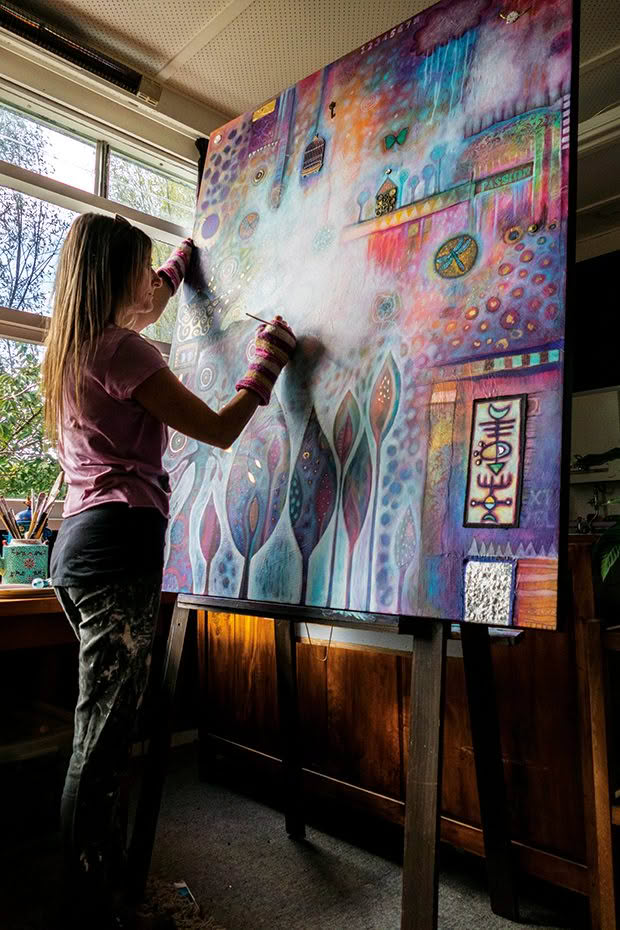
Belinda intergrates cast paper, gesso, gold leaf, dried flowers, brass keys, beads, glass, and other textural embellishments into her art.
Belinda’s quest to build her art space began in 2012. When browsing Trademe one day, she came across a two-hectare Eketahuna property with a straw bale house, and travelled to the Wairarapa to view it.
“The views of the Ruahines were amazing and the energy on the property was incredible,” she says. “It had a mystical essence about it. I didn’t know anyone around here – but I bought it and took the plunge.”
She struggled, however, to find a builder who’d give her a report on the house. They all cited a lack of experience in straw bale building. But she assumed the seven-year-old house had been built to standard as it had a Code of Compliance from the local council. What Belinda didn’t know was that Eketahuna had endured New Zealand’s largest earthquake – a magnitude 8.2 shake – in 1855. It has the dubious distinction of having the largest displacement (18 metres) along a vertical fault line ever recorded. And unlike wooden buildings that can sway in a quake, straw bale houses crumble. At least, her one did.
REBUILDING AND RECYCLING
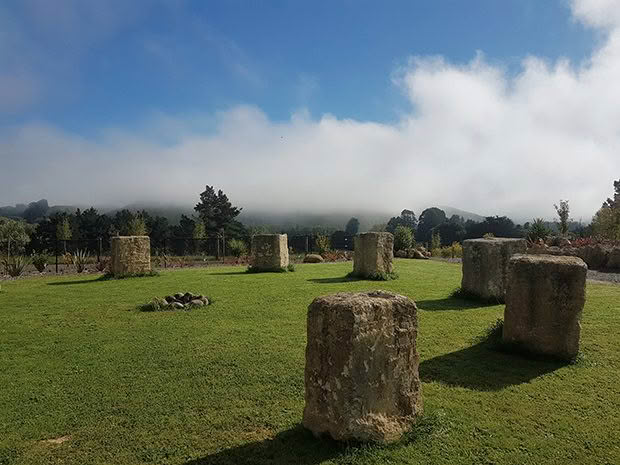
The repurposed concrete foundations.
After the 2014 earthquake, the only part of her house still intact was the wooden framing and beams supporting the turf roof. The plaster that covered the straw bale walls had disintegrated. While the local authorities cordoned off her home with red tape, the insurance company deemed it structurally sound and said it would cover the cost of repair. Yet Belinda had lost confidence in her ruined home and decided to demolish it and start afresh. It turned out to be the prudent decision. During demolition, she discovered undetected structural and construction faults that would have been hazardous had she continued living in the house once repaired.
She hired a 12-tonne digger and a five-tonne tipper trailer. She gave the straw and mud to the cows to play in, she repurposed the wooden beams (which were recycled power poles) to support deck shades, and she turned the 30mm marine ply that had supported her roof into everything from goat houses to retaining walls. She repaired and reused the doors and converted the concrete block foundations into a decorative fire pit reminiscent of Stonehenge.
But there was still the question of a new house and studio to live and create in. After a year of living in rental accommodation, Belinda found her solution: upcycling old buildings.
GOING OLD SCHOOL
Through her online research, Belinda discovered school and university buildings available for purchase and relocation. She found a disused classroom in Hawke’s Bay and relocated it to her property. The building and electricals were already certified, so all she had to do was install recycled French doors, a fireplace for winter and a deck for summer. She finally had her studio.
A year later, she found an old pink preschool classroom, brought it to her property and turned it into a one-bedroom chalet. She walled off a bedroom, enlarged the bathroom, added more doors and windows, installed a fireplace and kitchen and painted over the cartoon animals. At only 65 square metres, it is a compact, cosy home noticeably smaller than her studio. “Clearly your studio needs to be much bigger than your living space,” she says.
- The office block/lodge in various stages of development.
An old office block from Hamilton Polytechnic was added in 2019, and has been the biggest project so far. “I should’ve just bought a school,” Belinda says.
Unlike the previous buildings, this one required a major overhaul to turn it into the roomy, light-filled lodge it is now. The 140-square-metre building was relocated, redecorated, and insulated top and bottom. She installed new double-glazed aluminium joinery throughout, new bathrooms, new wiring, a new front entrance and a new kitchen. She repainted the exterior and landscaped the surrounding yard, adding
a barbecue area, spa pool and a large deck overlooking the Ruahine Ranges. The lodge is now equipped to accommodate 10 guests.
THE COST OF RECYCLING
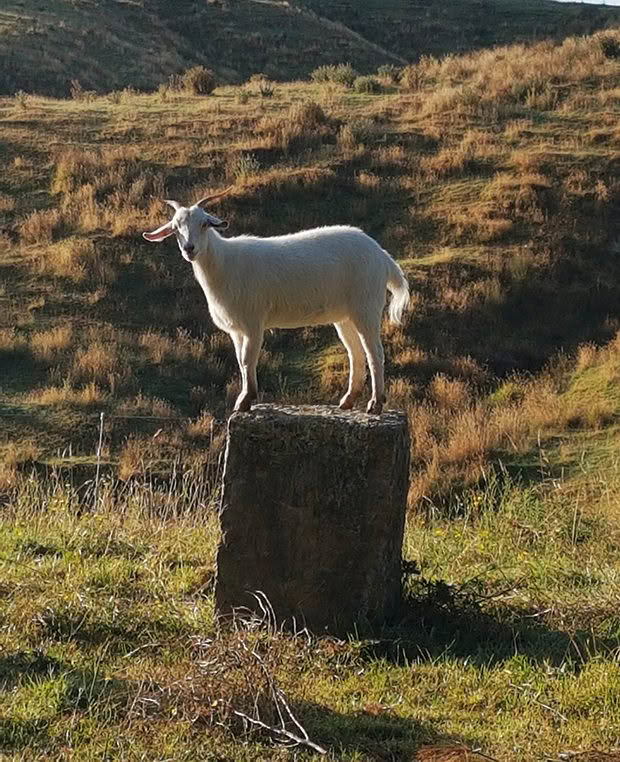
While repurposing buildings has worked out for Belinda, it can be quite a tedious process. She had to do her due diligence to ensure the floors were level and the electrical system and building was up to standard with required certifications.
But Belinda says the most important requirement is finding a reputable contractor to move the building. The contractor transported the 21-metre-long lodge up her steep driveway between power poles and trees, past the studio and chalet, and placed it perfectly level in one piece without any damage. “Fifteen neighbours had gathered to watch and were taking bets on whether it would take out the power pole, but it didn’t.”
Belinda hired tradespeople when needed but did the bulk of renovation work herself. Her partner helped out occasionally and her friend and neighbour, Jo Phillips, has often worked alongside Belinda to the beat of Abba and, ironically, the Carpenters.
“In hindsight, I could have built new with the amount of money I spent on that building. But it’s the ultimate in recycling,” says Belinda. “I’m giving it a whole new life. It would have been demolished if I hadn’t bought it and it was really satisfying to see it transform. I didn’t get designers in, I just did it one step at a time and the vision came together as I was going along.”
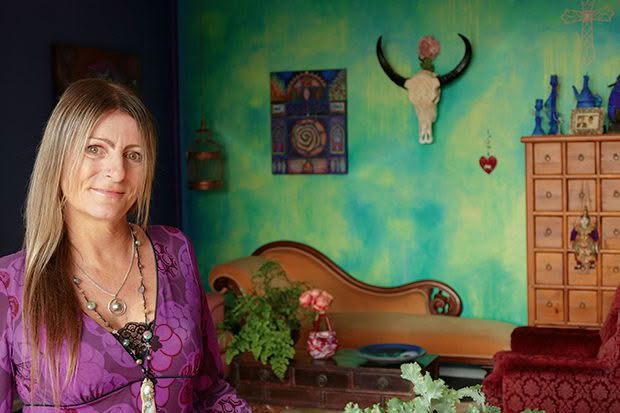
Belinda has been potting since she was a child.
GARDEN ART
Belinda’s creativity has extended to her garden. What was originally a bare hill has now been landscaped into a meditation dell: a Buddha pond teeming with goldfish, a private outdoor bath, a fairy-lit spa pool and the stone fire circle. She has plenty of natives and exotic trees and shrubs including hebe, roses, flowering cherries and wisteria, all of which flourish in her climate.
Most of the hard landscaping has been done with limestone rocks. “I’ve always loved rocks… I went to the Manawatu Gorge, jumped in the big truck and went up to the quarry and chose 25 tonnes of rocks. It was great fun. Much better than going to a mall.” A friend used a digger and precisely placed each rock to create gardens, traffic islands, retaining walls and steps. “They fit together like a jigsaw puzzle if you have the right digger driver,” Belinda says.
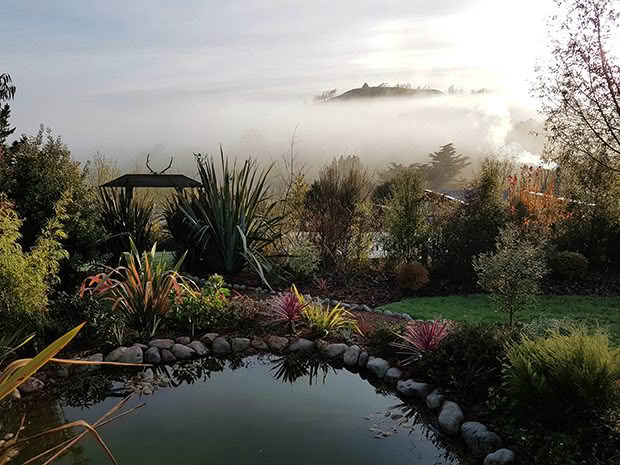
Surrounding a plastered couch awaiting mosaic tiling is the orchard and a lush vegetable garden which supplies the food for Belinda and her guests. “They called me the beetroot queen, my beetroot grew so huge. And the cabbages! Well, I got jars and jars and jars of sauerkraut from just one.” She attributes the size of her vegetables to copious amounts of sheep manure. Thanks to the garden and a couple of beef cattle that graze the land, Linda is able to source most of her food from the property.
THE CREATIVE FIRE
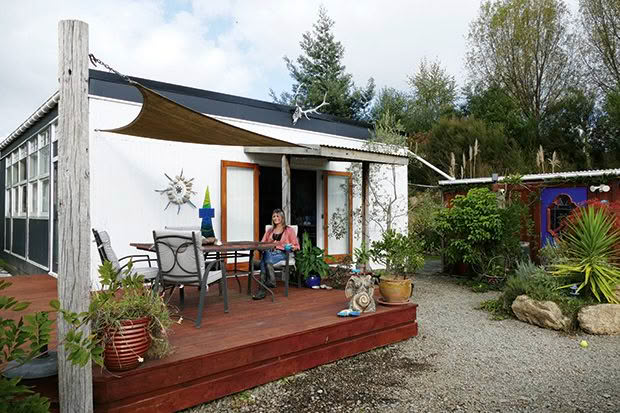
Her converted preschool studio
Belinda’s art evolves in the same eclectic and gradual way she built her home and studio.
Within her now-established artistic haven, she integrates cast paper, gesso, gold leaf, dried flowers, brass keys, beads, glass, and all sorts of additions and textural embellishments into her art. She describes her pottery as whimsical and her painting as spiritual, with every piece full of meaning, richness and texture. “There was no internet when I started so I learnt to create from my own imagination. I create with whichever technique pleases me at the time.”
“When somebody likes my painting so much that they want to take it home and put it on the wall – it’s like that painting was made for that person. It is like they really feel the energy within. And I know that painting is going to be adored.”
Belinda encourages people to channel this same intuitive style in her workshops, which she’s been hosting for over 20 years. She says it’s all about bringing the creative essence out to play. “A lot of people have always wanted to paint but had never allowed themselves that time. They’ve found my workshops and been blown away by what they could make over a weekend. It basically opens a door to people’s creative fire. It’s my way of giving back.”
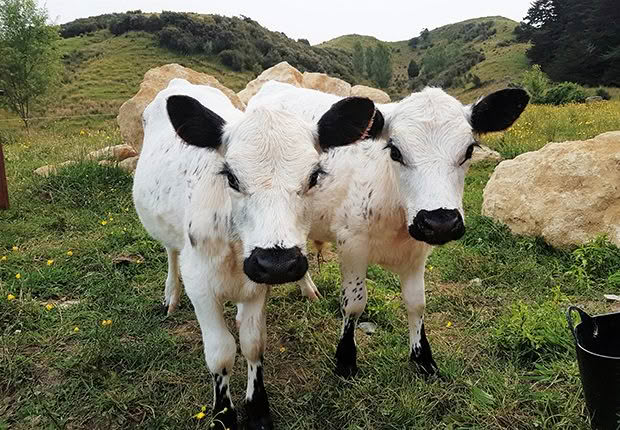
With very little accommodation in the area, Belinda’s lodge allows guests to book for a private party or join in a spiritual or artistic workshop. While she’s passionate about hosting groups of women for wellbeing activities, she’s not entirely sure about the word retreat.
“[Retreat] means going within. This property is all about expressing and encouraging what is already within to flourish. Jewellery making, exploring different art mediums, full moon gatherings, goddess weekends, hens parties… It’s about having women come together to spend quality time over nutritious food and celebration. It’s a space where people can come and stay and play, connect with mother nature, and just take a breath. It’s about nurturing the self. So many people don’t do that.”
HOW TO RELOCATE A BUILDING
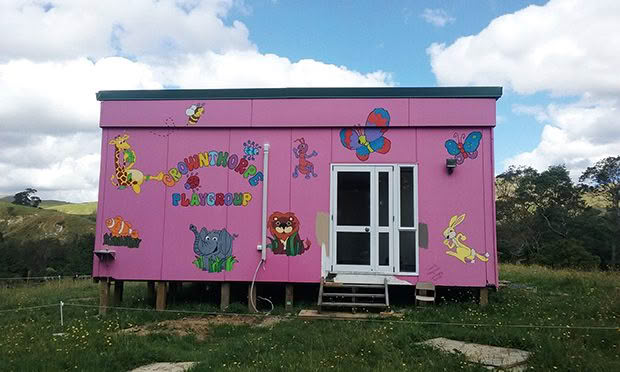
Trademe is filled with old houses and buildings selling for under $100,000 – a fraction of the median house price in New Zealand. The catch is that a buyer has to relocate the dwelling, which is not as simple, or affordable, as it sounds. Along with finding the right house or building, you’ll also need to submit multiple reports to the applicable council depending on the nature of your property and the house. These include:
• A geotech report to verify the strength of your soil and determine the foundations you’ll need to use.
• A second-hand building report to ensure the house is in a sound and suitable condition to be moved.
• Septic and storm water reports.
You’ll also have to factor in the cost of removal. On Trademe, contractors offer relocation services from $50,000 to $100,000 within a 100km distance. The cost will vary depending on the location of the land, the size of the house and if it needs to be transported in pieces.
Other costs include insurance, necessary repairs and renovations to the house to make it compliant, improving access to your site and constructing foundations.
The benefits are that it will still be cheaper than buying a standard non-relocatable home, the house will very likely be an older character home with native timber and joinery, and most importantly, you’ll probably be saving it from demolition.
Love this story? Subscribe now!
 This article first appeared in NZ Lifestyle Block Magazine.
This article first appeared in NZ Lifestyle Block Magazine.
